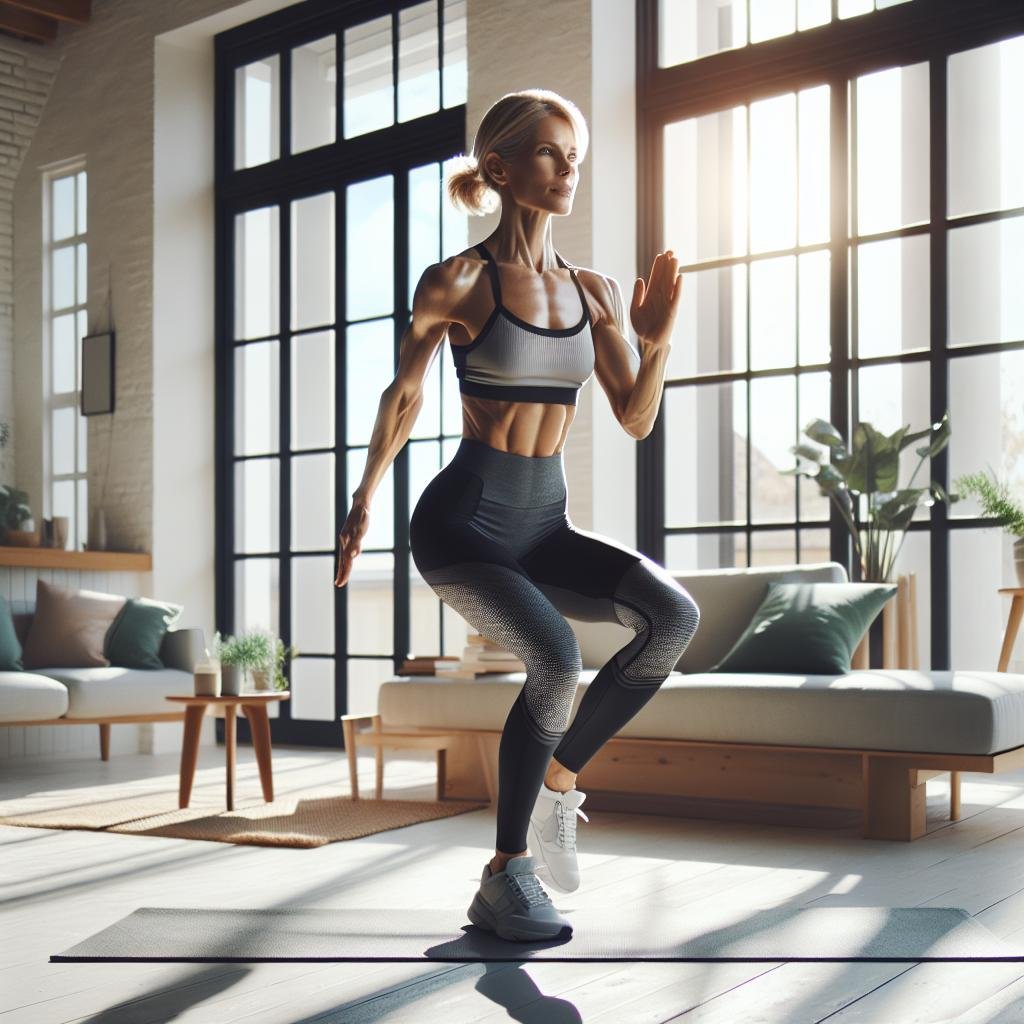
HIIT Home Workout at 51: Malaika Arora’s Effective Fat-Burning Secrets
High-Intensity Interval Training (HIIT) continues to prove itself as one of the most effective workout methods for burning fat and improving fitness—regardless of age. Bollywood fitness icon Malaika Arora recently demonstrated this truth perfectly, showcasing an impressive home HIIT routine at age 51 that has fitness enthusiasts talking. Her approach combines accessibility with effectiveness, proving that age is truly just a number when it comes to maintaining peak physical condition.
In this comprehensive guide, we’ll break down Malaika’s fat-burning HIIT techniques, explain why they work so well for midlife fitness, and provide you with actionable steps to implement similar routines in your own home workout regimen. Whether you’re in your 50s like Malaika or at any other stage of life, these evidence-based strategies can help transform your fitness journey.
The Science Behind HIIT’s Effectiveness at Any Age
HIIT workouts have gained tremendous popularity for good reason. These routines alternate between brief, intense exercise bursts and recovery periods. This approach creates what exercise physiologists call the “afterburn effect” or excess post-exercise oxygen consumption (EPOC), where your body continues burning calories long after you’ve finished exercising.
For adults over 50, HIIT offers particularly compelling benefits. Research published in the Cell Metabolism journal found that HIIT can reverse some cellular aspects of aging. The study showed improvements in mitochondrial function and protein synthesis that directly combat age-related muscle decline.
Furthermore, HIIT workouts typically require less time than traditional exercise sessions. This efficiency makes fitness more accessible for busy adults balancing multiple responsibilities. The intensity-recovery pattern also allows for adaptation based on individual fitness levels, making it suitable for beginners and advanced practitioners alike.
Breaking Down Malaika’s HIIT Home Workout
In her viral workout video, Malaika demonstrates a comprehensive HIIT routine that targets multiple muscle groups while elevating heart rate. Her routine features several key components that contribute to its effectiveness:
1. Dynamic Warm-Up Sequence
Malaika begins with mobility exercises that prepare the body for more intense movements. These include:
- Arm circles and shoulder rolls to loosen the upper body
- Hip rotations to improve joint mobility
- Light jogging in place to increase heart rate gradually
- Dynamic stretches for major muscle groups
This warm-up approach reduces injury risk while priming the body for optimal performance during the high-intensity segments. For adults over 50, thorough warm-ups become increasingly important as joint flexibility naturally decreases with age.
2. Bodyweight Circuit Elements
The core of Malaika’s routine includes these bodyweight exercises performed in rapid succession:
- Jumping jacks for cardiovascular conditioning
- Squats targeting the lower body powerhouse muscles
- Mountain climbers for core engagement and cardio
- Plank variations for full-body stability
- High knees for hip mobility and heart rate elevation
This no-equipment approach makes the workout accessible to anyone with enough floor space at home. Each exercise engages multiple muscle groups simultaneously, maximizing caloric burn and functional fitness benefits.
3. Strategic Rest Intervals
Malaika employs a 30-seconds-on, 15-seconds-off timing structure. This ratio provides enough intensity to trigger metabolic changes while allowing sufficient recovery to maintain proper form. The brief rest periods prevent the heart rate from dropping too low, keeping the body in the optimal fat-burning zone throughout the session.
Why Malaika’s Approach Works Especially Well After 50
Midlife brings physiological changes that can impact fitness routines. Malaika’s program addresses these age-specific concerns through several targeted strategies:
Hormone Optimization
After 50, hormonal shifts often contribute to increased fat storage, particularly around the midsection. HIIT workouts stimulate growth hormone production and improve insulin sensitivity, directly counteracting these midlife metabolic changes. This hormone optimization helps maintain lean muscle mass while reducing stubborn fat deposits.
Joint-Friendly Modifications
Malaika demonstrates modified versions of high-impact movements that protect joint health. For instance, she shows how to perform jumping exercises with reduced impact by decreasing jump height or substituting non-jumping alternatives. These modifications make the workout sustainable for those with joint concerns while still delivering results.
Progressive Intensity Approach
Rather than pushing for maximum intensity immediately, Malaika advocates for a progressive approach. She begins each exercise with controlled movement before increasing speed and power. This methodology respects the body’s need for adaptation, especially important for those returning to fitness after a hiatus or managing age-related changes.
Implementing HIIT in Your Home Routine: Practical Steps
Ready to incorporate Malaika-inspired HIIT into your fitness regimen? Follow these steps to create an effective and sustainable home workout practice:
Essential Equipment (Minimal Needed)
One of HIIT’s greatest advantages is its equipment flexibility. To get started, you’ll need:
- A non-slip exercise mat for floor exercises
- Comfortable, supportive athletic shoes
- A timer or fitness app for interval tracking
- Water bottle for hydration
- Optional: light dumbbells (2-5 lbs) for resistance variations
The simplicity of this setup makes HIIT particularly accessible for home workouts. No expensive machines or elaborate gym setups required—just enough space to move safely.
Sample 20-Minute HIIT Routine for Beginners Over 50
This beginner-friendly routine mirrors Malaika’s approach while providing appropriate modifications:
- Warm-up (5 minutes): Gentle marching in place, arm circles, hip rotations, and light dynamic stretches.
- Circuit 1 (5 minutes): 30 seconds of modified jumping jacks (step-outs instead of jumps), 15 seconds rest, 30 seconds of wall push-ups, 15 seconds rest, 30 seconds of seated knee raises, 15 seconds rest. Repeat once.
- Circuit 2 (5 minutes): 30 seconds of chair squats, 15 seconds rest, 30 seconds of modified mountain climbers (slower pace), 15 seconds rest, 30 seconds of standing side bends, 15 seconds rest. Repeat once.
- Circuit 3 (3 minutes): 30 seconds of marching in place with high knees, 15 seconds rest, 30 seconds of modified plank (from knees), 15 seconds rest. Repeat once.
- Cool-down (2 minutes): Gentle stretching for major muscle groups, focusing on shoulders, hips, and back.
Remember that consistency trumps intensity when beginning. Start with this routine twice weekly, gradually increasing to three or four sessions as your fitness improves.
Progressive Advancement Strategy
As your fitness level improves, implement these advancements to continue seeing results:
- Week 1-2: Focus on form and completing the full routine without modifications.
- Week 3-4: Increase work intervals to 40 seconds while maintaining 15-second rest periods.
- Week 5-6: Add light weights to appropriate exercises like squats and arm movements.
- Week 7-8: Introduce more challenging variations, such as squat jumps instead of basic squats (if joints permit).
- Week 9+: Consider adding a second HIIT session on non-consecutive days or incorporating resistance training on alternate days.
This gradual progression prevents plateaus while minimizing injury risk—a balanced approach that mirrors Malaika’s sustainable fitness philosophy.
Nutrition Support for HIIT After 50
Malaika frequently emphasizes that workout results depend heavily on nutritional choices. For optimal HIIT performance after 50, consider these dietary strategies:
Pre-Workout Fuel
Consume a small, balanced snack 30-60 minutes before your HIIT session:
- A banana with a tablespoon of almond butter
- Greek yogurt with berries
- Half a sweet potato with a sprinkle of cinnamon
- A small apple with a few walnuts
These options provide quick-access carbohydrates for energy along with some protein and healthy fats for sustained performance. Proper pre-workout nutrition becomes increasingly important after 50 as the body becomes less efficient at utilizing stored energy.
Post-Workout Recovery
Within 30 minutes after completing your HIIT session, prioritize protein and hydration:
- A protein smoothie with whey or plant-based protein
- Two hard-boiled eggs with whole grain toast
- Grilled chicken or tofu with roasted vegetables
- Salmon with quinoa and steamed greens
This recovery window helps build and maintain muscle mass—crucial for metabolic health after 50 when natural muscle loss (sarcopenia) accelerates without intervention.
Daily Hydration Requirements
HIIT increases fluid needs, particularly for older adults who may have diminished thirst sensation. Aim for:
- At least 8-10 glasses of water daily as a baseline
- An additional 16-20 ounces for each 30 minutes of HIIT
- Electrolyte-containing fluids if workouts exceed 45 minutes
Proper hydration supports joint health, temperature regulation, and overall exercise performance. Consider keeping a water bottle visible throughout the day as a reminder to drink regularly.
Common Mistakes to Avoid When Starting HIIT After 50
Even with excellent examples like Malaika’s routine, beginners often make several mistakes when implementing HIIT workouts:
Skipping Proper Form for Speed
Prioritizing movement quantity over quality increases injury risk without improving results. Instead, master proper form at slower speeds before increasing intensity. Record yourself occasionally to check form, or work with a certified fitness professional for initial guidance.
Insufficient Recovery Between Sessions
After 50, recovery capacity often decreases. Allow 48-72 hours between HIIT sessions to prevent overtraining and promote optimal adaptation. Active recovery like walking, swimming, or gentle yoga on rest days maintains momentum without overtaxing the system.
Neglecting Warm-Up and Cool-Down
The temptation to jump straight into the high-intensity portion can be strong when time is limited. However, skipping proper preparation and recovery bookends significantly increases injury risk. These phases should comprise approximately 30% of your total workout time.
Starting Too Intensely
Beginning with workouts that are too challenging leads to discouragement and potential injury. The ideal starting point should feel challenging but manageable, with the ability to speak in short sentences during the most intense intervals. This indicates appropriate exertion levels for beginners.
The Psychological Benefits of Malaika’s HIIT Approach
Beyond the physical transformation, Malaika’s HIIT practice demonstrates significant mental health benefits that become increasingly valuable after 50:
Cognitive Function Enhancement
Research published in the Journal of Gerontology shows that HIIT improves cognitive performance in adults over 50. The increased blood flow to the brain and release of brain-derived neurotrophic factor (BDNF) during high-intensity exercise supports neural health and potentially reduces cognitive decline risk.
Mood Regulation and Stress Management
The endorphin release triggered by HIIT workouts creates the famous “runner’s high” that combats midlife stress and mood fluctuations. Regular practitioners often report improved emotional resilience and decreased anxiety symptoms. This natural mood enhancement can be particularly beneficial during perimenopause and menopause when hormonal shifts often impact emotional well-being.
Confidence Building Through Progressive Achievement
Malaika frequently discusses how her fitness practice builds confidence that extends beyond physical appearance. The structured progress of HIIT provides regular wins as practitioners master increasingly challenging movements. This sense of accomplishment often translates to greater self-efficacy in other life areas.
Conclusion: The Sustainable Path to Fitness After 50
Malaika Arora’s HIIT home workout demonstrations provide more than just exercise instruction—they offer a philosophy of sustainable fitness that embraces aging while refusing to be limited by it. Her approach combines scientific principles with practical application, creating accessible pathways to improved health regardless of age or starting fitness level.
The key takeaway isn’t that everyone should look like a Bollywood fitness icon at 51, but rather that consistent, well-designed HIIT workouts can deliver remarkable results for anyone willing to commit to the process. By focusing on form, appropriate progression, and recovery, you can harness the power of high-intensity interval training to transform your fitness journey.
Remember that fitness after 50 isn’t about turning back the clock—it’s about optimizing your health for the decades ahead. With Malaika’s approach as inspiration, you have a blueprint for creating a stronger, more energetic future through the power of home-based HIIT workouts.
Have you tried incorporating HIIT into your fitness routine after 50? What challenges or successes have you experienced? Share your journey in the comments below!
References
- Cell Metabolism: Enhanced Protein Translation Underlies Improved Metabolic and Physical Adaptations to Different Exercise Training Modes in Young and Old Humans
- Journal of Gerontology: High-Intensity Physical Exercise in Aging: Benefits and Risks
- American College of Sports Medicine: HIIT Training Guidelines
- Mayo Clinic: Fitness Tips for Maintaining Health as You Age
- Hindustan Times: Malaika Arora’s HIIT Home Workout


